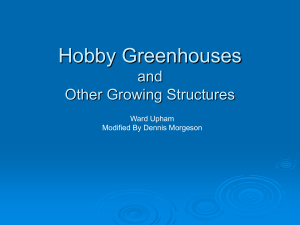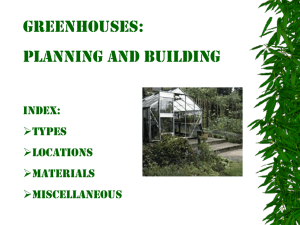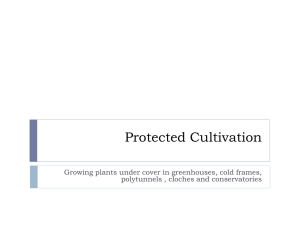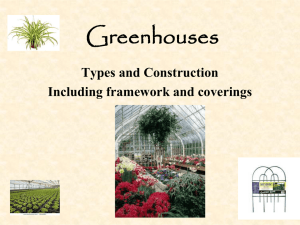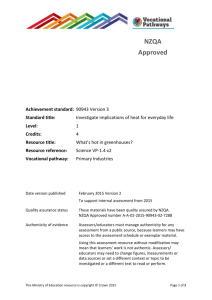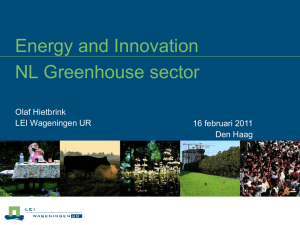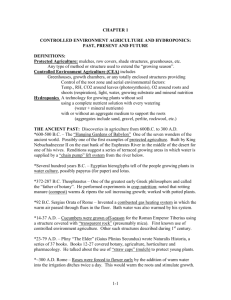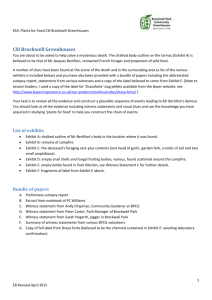Chap 3.Environment and facilitiesx
advertisement
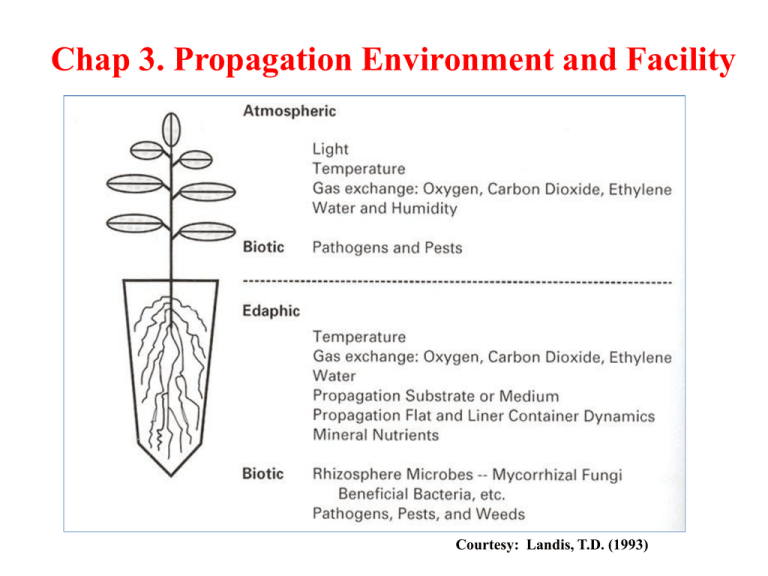
Chap 3. Propagation Environment and Facility Courtesy: Landis, T.D. (1993) Environmental Controls 1. 2. 3. 4. 5. 6. Light Temperature Growing Media Plant Nutrition Humidity Carbon Dioxide 1. Environmental factors A. Light - Electromagnetic spectrum - Solar radiation vs. artificial lights a. Quality - what wave length the light belongs to - perceived by the human eye as color. - red light and far-red light - effects plant height and development b. Quantity - intensity or brightness of light - radiometric and photometric measurements - influence on photosynthesis c. Duration - influenced by longitude and season - photoperiods: long-day, short-day, day-neutral Light Quality 1. What does it mean? What spectrum of light does it involve? (Red, blue, green, orange, or infrared lights, etc.) 2. Measurements a. Wave lengths: distance from peak to peak or valley to valley in units of nm or µm µm = 10-3 mm nm = 10-6 mm Å = 10-3 nm b. Wave number: number of waves per cm of light (number/cm) c. Frequency: number of cycles per second (cycles/sec, cps) Hertz (Hz) = 1 cycle/sec Mega Hz = 1 million Hz Composition of Visible Light Red Orange Yellow Green Blue Indigo Violet Source: NASA Light Intensity 1. What does it mean? How much irradiated on the surface (Quantity) 2. Radiometric measurements a. Light intensity measured in terms of power of radiation on a unit surface area Power = energy/unit time Intensity = power/unit area, energy/unit area per unit time b. Measurement units: Joules cm-2 sec-1, watts cm-2, BTU ft-2 hr-1, kcal cm-2 hr-1 c. The shorter the wave length, the more the energy available. 3. Photometric measurements a. Light intensity expressed in terms of illuminance or how bright the light is (visible radiation only) b. Measurement units: Foot candles, lumens, lux, µmol m-2 sec-1 c. Relationships: 1 lux = 1 lumen m-2 1 foot candle = 10.76 lux 4. Factors affecting light intensity a. Moisture in the air: No. of clear days in January: 70-80% in AZ, 30-40% in NY b. Topography: Higher the altitude, brighter the light c. Pollutants in the air: PAN, SO2, NOx, etc. Duration of Light 1. What does it mean? How long the light was on 2. Factors that affect light duration a. Time of the year (seasonal variation) b. Latitudes (both northern and southern hemisphere) Fargo: 56.5 N 3. Photoperiod responses a. Long day plants (short night plants) Requires days longer than 16 hours to bloom Aster, petunia, potato b. Short day plants (long night plants) Requires days shorter than 13 hours to bloom Chrysanthemum, poinsettia, kalanchoe c. Mechanism of responses Phytochrome system P660 – red light absorbing form P730 – far-red light absorbing form Influence of Photoperiod on Flowering Spectral Distribution of Various Lamps Lighting for Photosynthesis 1. Environmental factors (continued) B. Temperature • Optimum temperature - For most plants: 70 oF day and 60 oF night • Importance – some examples - Cold-moist stratification breaks dormancy of some seeds - Warm temperature of soil medium improves germination and rooting - Heat applied to graft union to speed callusing and tissue joining - Bottom heat on propagation bench stimulates rooting, more cost-effective than heating whole greenhouse. Use of psychrometric chart in greenhouse cooling Pad and Fan Evaporative Cooling System High pressure fogging system Growing Media Water 25% Ideal Composition Mineral 45% Solid 45% mineral 5% organic matter Water Air Air 25% Organic Matter 5% 50% 25% 25% Soil Amendments Sand: low water-holding, low CEC, heavy, size varies used as inert medium Vermiculite: expanded mica mineral high water-holding, good CEC, high buffering Perlite: heated, popped volcanic rock (inert) very light, no CEC, no buffering or nutrient holding Calcined Clay: baked montmorlillonite clay, aggregate particles heavy, durable, high CEC Pumice: Crushed volcanic rock (inert) low water-holding, low CEC Peat: about 75% decomposed sphagnum peatmoss high water-holding, high CEC, low pH Using Soil in Growing Media a. Heavy Texture Soil Use: 1 part clay loam 2 parts organic matter 2 parts coarse aggregate (amendments) b. Medium Texture Soil Use: 1 part silty loam 1 part organic matter 1 part coarse aggregate (amendments) c. Light Texture Soil Use: 1 part sandy loam 1 part organic matter Adjustment of Soil pH • To raise soil pH – Ground limestone (CaCO3) – Dolomitic lime (mixture of CaCO3 + MgCO3) – Gypsum (CaSO4) • To lower soil pH – – – – Sulfur powder (S) Aluminum sulfate [Al2(SO4)3] Iron Sulfate (FeSO4) For solution, use: • Sulfuric Acid • Phosphoric Acid • Nitric Acid (H2SO4 ------------► 2H+ + SO4-2) (H3PO4 ------------► 3H+ + PO4-3) (HNO3 ------------► H+ + NO3-) Rockwool used as growing media for tomato production Fertilizer Application Fertilizer Injection Fertilizer Stock Tanks Purification of Water - Filtration - Reverse Osmosis (RO water) - Distillation (DI water) Fluctuation of CO2 Concentration Inside a Greenhouse in One Day 2. Environmental Control Facility 1. Cold frames 2. Hotbeds 3. Greenhouses 4. Shade houses 5. Other structures Cold Frames Semi-controlled environment Used for hardening seedlings and rooted cuttings Can also be used for vernalizing herbaceous perennials Hotbeds Small, low structures for minimum environmental control Some bottom-heated - Use of electrical cables, hot water, stream - Heat from organic waste (manure, straw) was used earlier days Possible problems - Seedling damping-off (Pythium, Rhizoctonia) - Complete control of temperature difficult Structural Designs of Greenhouse 1. Lean-to Greenhouses 2. Single Span Greenhouses - Even-span greenhouses - Uneven-span greenhouses - Arch or curvilinear greenhouses 3. Ridge-and-Furrow Greenhouses - Gutter connected multi-span greenhouses 1. Lean-to Greenhouses Build against a side of an existing building Advantages: Less heating costs Easy access to harvesting crops Disadvantages: Humid air into the house Chemical spray health hazard (use biological control) Earlier Greenhouses Modern Greenhouses 2. Single-Span Greenhouses Modified temporary Quonset greenhouses, NDSU campus Standard Single-Span Greenhouses Construction of a Quonset Greenhouse

